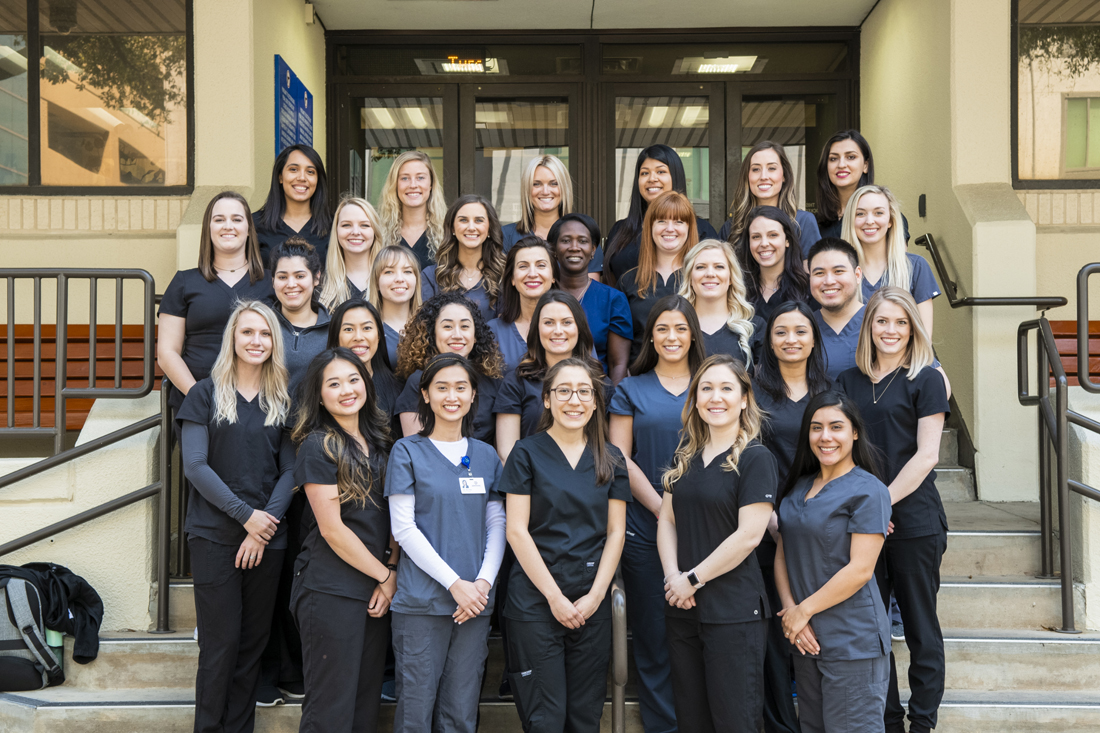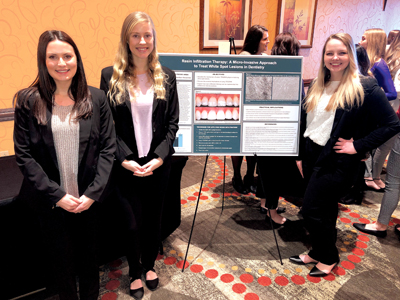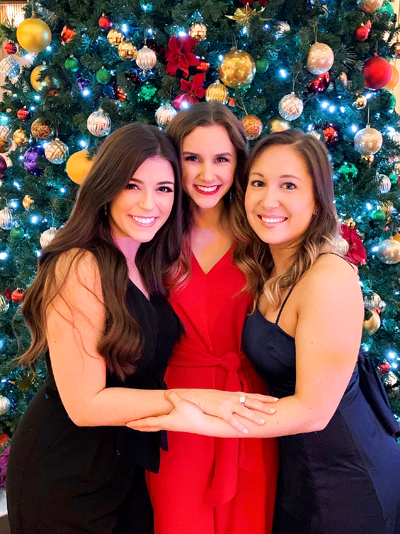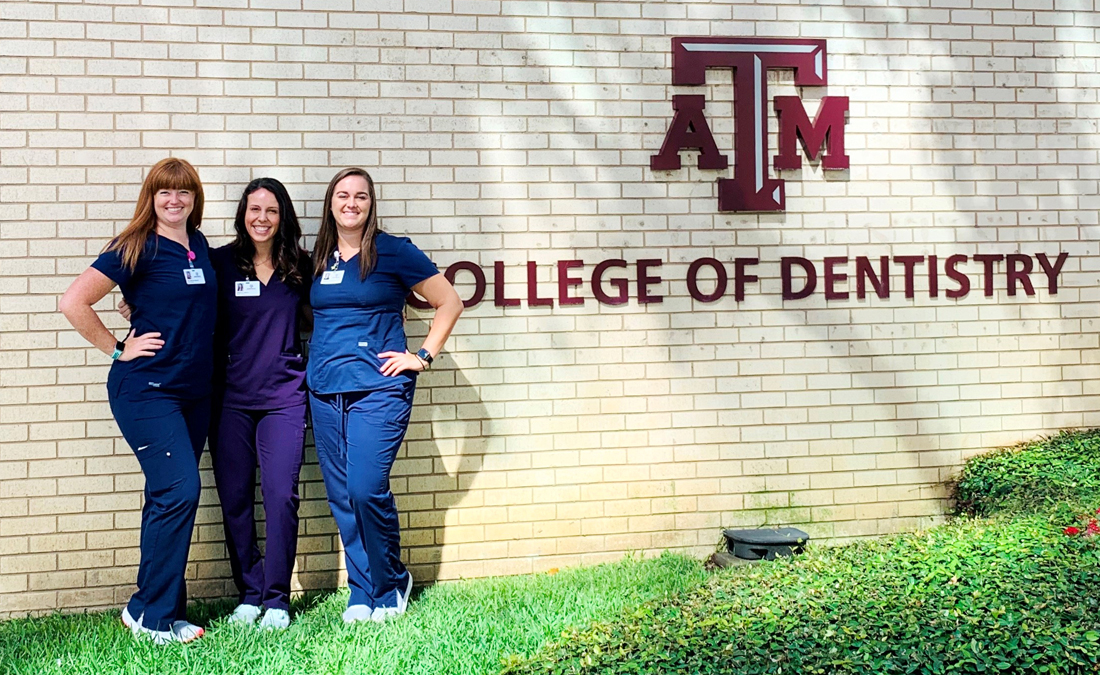From presentation to peer-reviewed journals

Caruth School of Dental Hygiene students have one-upped themselves, going above and beyond their streak of winning research poster presentations at both the state and national levels. Next stop? Publication.
Eight out of nine research groups have submitted their research to peer-reviewed journals, says Dr. Faizan Kabani, assistant professor and director of the undergraduate dental hygiene research program.
“We continue to be amazed by our students and their incredible display of passion in research and applying their skills toward evidence-based practice,” he says. “Students, through our revamped research program, continue to achieve local, state and national accolades and are increasingly recognized by the dental hygiene community.”
The recent graduates are seeking publication in either the Dimensions of Dental Hygiene journal or the Journal of Dental Hygiene.

“We put so much effort into our topic, and we want to share it with the masses,” says student researcher Melanie Patterson ’20, who teamed up with Kimberlynn Patzold ’20 and Abbigale White ’20. “We created something I am proud of, and that, I hope, will be eye-opening to others in our industry.”
Their group focused on “Infectious Disease Disclosure by Dental Health Care Providers: A Patient’s Right to Know?” They addressed a lesser-known state regulation that presents possible hefty implications. Patterson says they settled on the topic after hearing Dr. Patricia Simons’ ethics lecture on Rule 108.25 in the Texas State Board of Dental Examiners’ rules and regulations. That rule states, “A dental health care worker who is infected with HIV or HBV and is HBeAg-positive shall notify a prospective patient of the dental health care worker’s seropositive status and obtain the patient’s consent before the patient undergoes an exposure-prone procedure performed by the notifying dental health care worker.”
Their research presentation placed second in the Texas Dental Hygienists’ Association competition in San Marcos in February and third place in the Caruth School of Dental Hygiene Research Scholars Day in early March. Mentors for the project were Leigh Ann Wyatt and Tracy King, both clinical associate professors in dental hygiene.
When the group presented at the TDHA annual conference, Patterson says they discovered how most attendees were not only unaware of the state rule but were strongly opposed. The student researchers hope that by being published, their work will effect public policy change, which would be beneficial to their professional peers.
“I think publication of our research would open the eyes of dental health care providers in Texas and other states to what this rule could mean for the infected provider and their potential patients,” Patterson says. “This rule carries the possibility of serious consequences such as loss of practice for providers, prejudice toward the provider, and possibly fewer career and educational opportunities.”

The dental hygiene grads credit their research success to Kabani’s efforts since he joined the program. He has been a leading force in forming a research partnership between Caruth and the Undergraduate Research Scholars program, which is a LAUNCH initiative at Texas A&M University. He also is working toward ensuring that future dental hygiene students are designated “undergraduate research scholars” on their transcripts and receive a medallion for commencement ceremonies. This would possibly open the door for these students to further pursue research in their careers or pursue graduate degrees, he says.
“By obtaining LAUNCH alignment, the student and Caruth receive further recognition for the quality of research we are doing. And with more recognition comes more confidence. Dr. Kabani takes the opportunity with students’ raised level of confidence and guides them to publish in a peer-reviewed journal,” says Wyatt, executive director and program director at Caruth. “In this graduating class, most groups did just that—and we couldn’t be more proud of them as professionals and as researchers who do every step with excellence.”
These dental hygiene students say a whole world is opening up that they never expected to explore. Going forward, they hope to reap the benefits of learning one more facet of their profession.
“As a health care professional, I believe it is important that I continue to research and stay up to date on the current literature in dentistry in order to offer the best care to my patients. Knowing how to research, read and interpret scientific literature will help add to my toolkit as a professional,” says Courtney Fine ’20, who presented “Resin Infiltration Therapy: A Micro-Invasive Approach to Treat White Spot Lesions in Dentistry” with classmates Danielle Allen ’20 and Malorie Newton ’20.
The group’s research received first place at both the Texas Dental Hygienists’ Association competition and Caruth School of Dental Hygiene Research Scholars Day. It also placed third in the Dallas Dental Hygienists’ Association competition. Mentors were Clinical Professor Kathleen Muzzin and Kayla Reed, adjunct faculty member.

“Learning the ins and outs of how to properly research a topic has improved my critical thinking skills tenfold,” Newton says. “Any time that I hear a claim, my mind automatically goes to the question of ‘What source did they get their information from?’ This mindset will be extremely helpful when a patient wants to know about a product, its effects and whether they should buy it or not.”
Allen says her group worked well together and came out with a great amount of respect for the time and effort that goes into research. The process also prompted a new respect for each other.
“We all brought different writing styles and perspectives into the project and learned so much from one another,” she says. “We became closer in our program and also in our personal friendship.”
A third group of students—Alexandra Politz ’20, Lauren Scott ’20 and Hannah Montz ’20—also received kudos for their work, “Ammonium Hexafluorosilicate: A Prospective Alternative to Silver Diamine Fluoride.” They won first place in the Dallas Dental Hygienists’ Association competition. Muzzin and Reed were their mentors.
“We are proud of our students because of who they are. Period,” says Wyatt. “If they choose to dedicate themselves to taking their research to publication, it is just an indicator of their love for research and a belief in their research project.”
